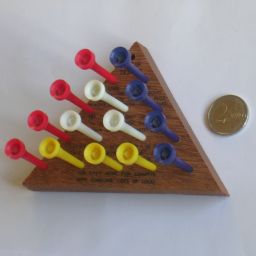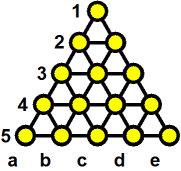


This version of Peg Solitaire is played on a triangular board, with 15 holes. The edge of the triangle is five holes long. At the start, all but one hole contains a peg. A move consists of jumping one peg over another to land in a vacant hole, and then removing the peg that was jumped over. At the start of the move, the jumping peg, the peg jumped over, and the landing hole must be adjacent and lie in a straight line. The aim of the puzzle is to remove all but one of the pegs.
Most versions of this puzzle are made of wood, and use golf tees for the pegs.
I don't think there is any way to calculate this directly. Instead I have written a computer program to enumerate all the reachable positions. The results are shown in the table below.
| Starting hole: | a1 | a4, d4 | c5 | b3 | |
|---|---|---|---|---|---|
| J u m p s | 0 | 1 | 1 | 1 | 1 |
| 1 | 2 | 2 | 4 | 2 | |
| 2 | 8 | 6 | 16 | 6 | |
| 3 | 35 | 24 | 59 | 21 | |
| 4 | 122 | 79 | 186 | 58 | |
| 5 | 293 | 193 | 446 | 139 | |
| 6 | 530 | 375 | 760 | 260 | |
| 7 | 679 | 525 | 931 | 350 | |
| 8 | 623 | 519 | 840 | 351 | |
| 9 | 414 | 366 | 583 | 261 | |
| 10 | 212 | 196 | 285 | 142 | |
| 11 | 75 | 70 | 98 | 49 | |
| 12 | 18 | 17 | 23 | 10 | |
| 13 | 4 | 4 | 5 | 1 | |
| Total | 3016 | 2377 | 4237 | 1651 | |
| Final peg: | a1, a4, c5, d4 | a1, a4, c5, d4 | a1, a4, b3, c5, d4 | c5 | |
For further analysis techniques, see the Analysis of Peg Solitaire page.

I will label the rows from top to bottom with the numbers 1 to 5, and the columns from left edge to the right corner starting with the letters a to e. Every board location then can be denoted by its coordinates, e.g. the corners are a1, a5 and e5. Any jump can be described by two coordinates, of the start and end hole of the jump, e.g. b5-d5 for a jump to the right along the bottom edge.
This is quite a tricky puzzle for its size, because there are certain moves that make it impossible to finish the game. If you know to avoid these moves, then the puzzle is fairly easy. There are two types of move that are to be avoided:
Here are some solutions. Jumps into a corner are shown in bold. There are no jumps out of the interior.
| Start | End | Moves |
|---|---|---|
| a1 | a1 | a3-a1, c3-a3, a1-c3, d4-b2, c5-c3, b2-d4, e5-c3, a5-c5, a4-a2, d5-b5, b5-b3, c3-a3, a3-a1 |
| a1 | a4 | a3-a1, c3-a3, a1-c3, d4-b2, c5-c3, b2-d4, e5-c3, a5-c5, a4-a2, d5-b5, b5-b3, c3-a3, a2-a4 |
| c5 | a1 | a3-c5, b2-b4, a1-a3, d4-b2, c5-c3, b2-d4, e5-c3, a5-c5, a4-a2, d5-b5, b5-b3, c3-a3, a3-a1 |
| c5 | a4 | a3-c5, b2-b4, a1-a3, d4-b2, c5-c3, b2-d4, e5-c3, a5-c5, a4-a2, d5-b5, b5-b3, c3-a3, a2-a4 |
| a4 | a4 | a2-a4, c3-a3, a1-c3, d4-b2, c5-c3, b2-d4, e5-c3, a5-c5, a4-a2, d5-b5, b5-b3, c3-a3, a2-a4 |
| a4 | d4 | a2-a4, c3-a3, a1-c3, a4-a2, c5-a3, a2-a4, a5-a3, e5-c5, b5-d5, d5-b3, d4-b2, a3-c3, b2-d4 |
| c5 | b3 | a5-c5, d5-b5, a3-c5, a1-a3, b5-d5, c3-c5, e5-c3, a4-a2, a2-c4, b2-d4, d4-b4, d5-b5, b5-b3 |
| c5 | c5 | a5-c5, d5-b5, c3-c5, e5-c3, b2-d4, a3-c3, d4-b2, a1-c3, c5-a5, a5-a3, a2-a4, a4-c4, c3-c5 |
Note that if, for example, you want to start at a4 and finish at a1, then you can do the inverse of the a1 to a4 solution above. These 8 solutions, together with their inverses, rotations, and mirror images, can supply a solution for any solvable combination of starting hole and final peg location.
For further analysis techniques for this and other peg solitaire games, see the Analysis of Peg Solitaire page.